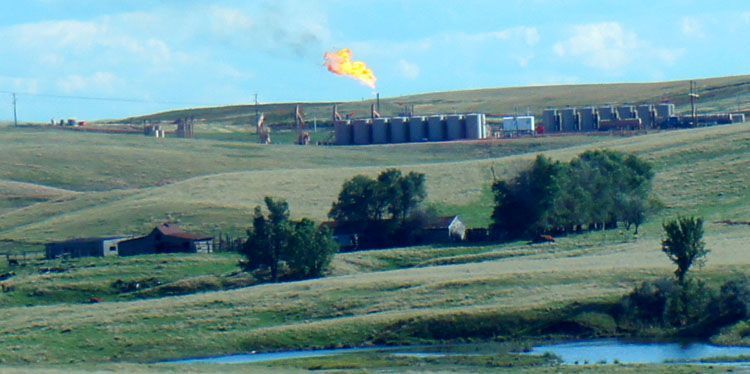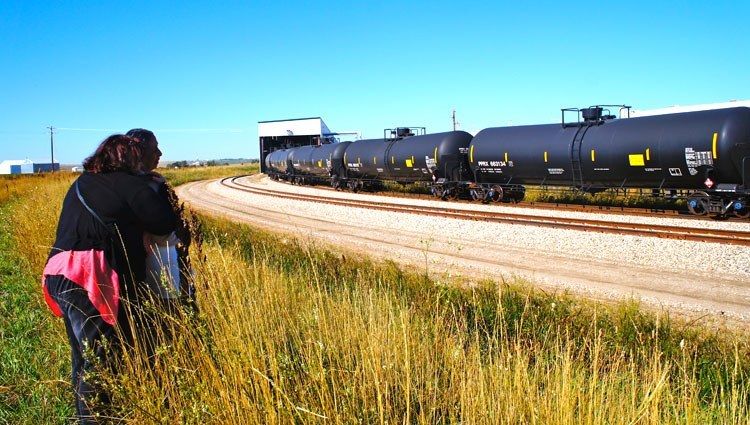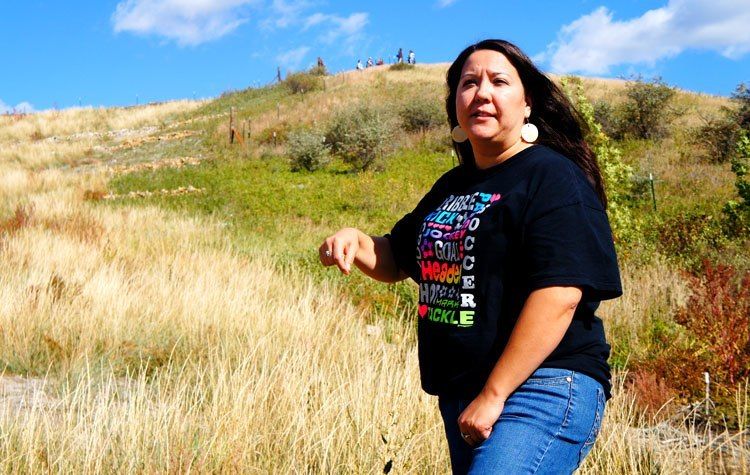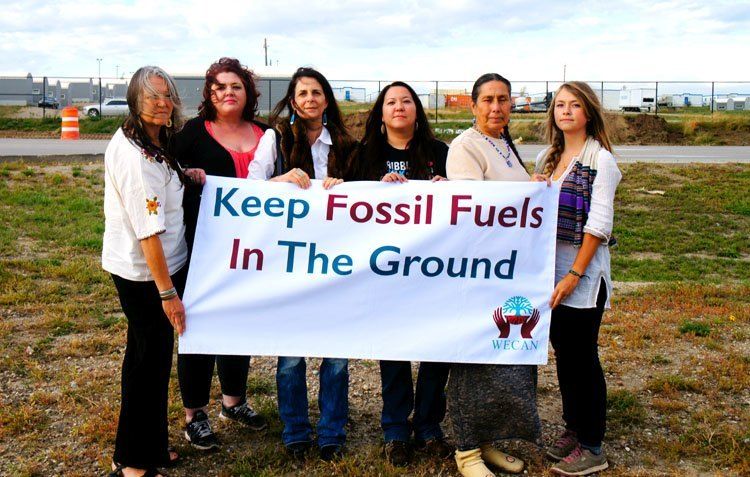
Women on the Front Lines Fighting Fracking in the Bakken Oil Shale Formations
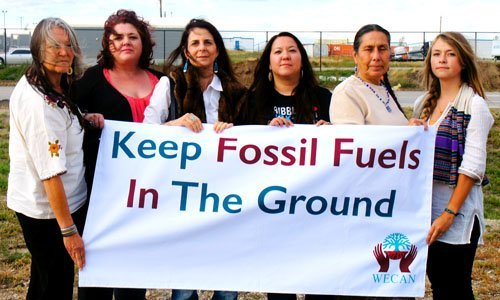
By Emily Arasim and Osprey Orielle Lake
There are some crystalline moments in which the challenges we face as a civilization become brutally clear. Moments in which corrupt aspects of American democracy and the fractures in our social, economic and political systems are exposed with unsurpassed clarity.
Moments in which we are reminded of how fundamentally ruptured our dominant culture’s relationship with the Earth has become and in which we see before our eyes how this split has led to almost unfathomable acts of violence against the Earth, against women and against the original inhabitants of North America.
Standing on the sweeping, golden prairie of North Dakota with the noxious flames of the Bakken fracking fields visible in all directions, one such moment descended with heavy weight.
Rape of the Land, Rape of the Women
“The Bakken” is a shale formation that spans some 25,000 square miles and covers much of western North Dakota, eastern Montana and the southern parts of two Canadian provinces. Since the early 2000’s, a boom in oil extraction has taken place in the region thanks to newly available hydraulic fracking technologies used to extract sticky, heavy oil from deep within shale rock. In less than a decade, North Dakota has become a fracking epicenter and the second largest U.S oil-producer after Texas.
For millennia before becoming the center of the fracking industry, northwest North Dakota served primarily as rich agricultural grounds and as the home of the Three Affiliated Tribes of the Mandan, Hidatsa and Arikara peoples.
For the Three Affiliated Tribes, the social and environmental destruction wrought by the fracking industry is but the latest wave of historic oppression and colonization. In 1947, the Mandan, Hidatsa and Arikara were forcibly moved from their traditional lands to make room for the construction and flooding of Lake Sakakawea on the Missouri River.
Of the 12 million acres promised to the Three Affiliated Tribes by an 1851 treaty, less than 1 million acres have been delivered in the form of the Fort Berthold Reservation and now these remaining acres are being eaten away by destructive development, cultural dislocation and irremediable ecologic damage cause by the fracking industry.
Williston, a mid-sized town just outside of Fort Berthold Reservation, has officially adopted the new town slogan “Boomtown, USA” and has been taken over by the industry to the point that it is almost unrecognizable to residents, both Indigenous and non-Indigenous, whose families have lived there for generations.
The population of Williston has doubled , maybe even quadrupled since 2010, however exact numbers are too hard to track due to the transient flow of labor and utter inability of local government to keep up.
Law enforcement and social services have been stretched far past their limits, leaving many, especially Indigenous women and girls, exposed, vulnerable and without proper legal protection.
While there are some families and women moving to the area to partake in work on the fracking fields and sprawling hotels and strip malls that have popped up to service the workers, the majority of the tens of thousands of new residents are men. In recent years the demographic has changed to the point that there are now more men concentrated in North Dakota than anywhere else in the U.S outside of Alaska.
Workers are housed in ever-expanding mobile home complexes called “man-camps,” ranging from unregulated trailers in farmers’ fields to sprawling complexes housing and feeding more than 1,000 workers at a time.
Conditions for fracking workers are cramped and have proven to be breeding grounds for violence, drug use and sexual abuse. The population influx and housing demands had driven up rents to exorbitant rates rivaling New York City and San Francisco, squeezing out long-term residents and putting many at risk of homelessness.
According to the state’s Uniform Crime Reports, violent crime, including murder, aggravated assault, rape and robbery increased by 125 percent between 2005 and 2013.
In September 2013, the U.S. Department of Health and Human Services identified two small towns in the Bakken alongside four major cities (Boston, Houston, Atlanta and Oakland), as the places in the U.S most in need of assistance to combat rampant sex and human trafficking.
In North Dakota, as in many places across the world, violence against women intersects with and is multiplied by deep racism and a legacy of exploitation, systemic violence and genocide of Indigenous peoples.
According to U.S Department of Justice records, one in three Native American women are raped in their lifetimes, a figure that is two-and-a-half times greater than the average for all U.S. women.
In an astounding 86 percent of cases of rape of Indigenous women and girls, the assailant is non-Native, which has proven to be a fatal catch-22 allowing many crimes to go uninvestigated by either U.S or Tribal officials.
Williston’s rape rate is now nearly four times the national average and in 2014, shelter workers reported a more than four-fold increase in domestic violence cases.
From the biggest industry supporter to the staunchest critic, everyone in the North Dakota Bakken is quick to admit that the region feels like an uncontrolled, “wild west.” This violent lawlessness bears down upon Indigenous women and girls with unmatched brutality.
In April of 2015, a coalition of Indigenous and women right’s organizations, led by Honor the Earth, filed a request with the United Nations Expert Mechanism on the Rights of Indigenous Peoples, demanding a UN intervention in the epidemic of sexual violence brought on by extreme fossil fuel extraction in Bakken fracking fields and the Alberta, Canada tar sands region.
While violence against Indigenous and other local women in the region continues to be pushed under the cover, the very visible rape of the Earth happening across North Dakota is harder to ignore.
The North Dakota Industrial Commission cites nearly 2,000 spills, leaks, ruptures, fires and blowouts over the past 12 months and the Associated Press recently uncovered at least 750 “oilfields incidences” hidden from the public since January 2012. More than 75 tons of oil waste is generated in the state every day, one third of which is highly radioactive.
Radioactive “frack socks,” used to filter solids from toxic fracking water, are produced by the hundreds of thousands every day. Waste disposal sites in North Dakota are not allowed to accept these radioactive materials, the result being that thousands of filters are being illegally dumped by industry workers, most notably on back roads, dumpsters and playgrounds of the Fort Berthold reservation.
While fracking is happening across the U.S, there are a several elements of the North Dakota industry that set it above the rest when it comes to devastation of the land and the health of local communities.
The massive worker influx and targeting of Indigenous communities are two such factors—flaring or the burning off of the natural gas extracted during the fracking process, is another.
Across the U.S, an average of just 1 percent of gas is flared, while the rest is captured and used as productive energy. In North Dakota, upwards of 26 percent is burned off, creating an additional source of volatile pollution and waste and serving as a testament to the industries flagrant disregard for the health of people and Earth in North Dakota.
Carbon dioxide, methane and many other hydrocarbons and carcinogens have been identified in samples, however companies are not required to disclose the exact chemical composition of the flared gases, which compromise local air quality, have been linked to cancer, asthma and respiratory disease, and astonishingly, can be seen glowing from space in the previously dim, sparsely populated North Dakota plains.
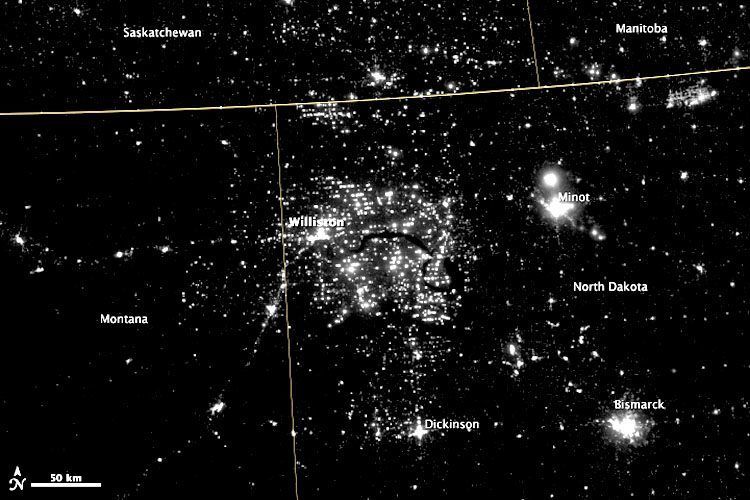
Flares are highly toxic when lit, but even more devastating when the flames go out and gases pour out unseen, creating gas plumes over local communities for hours, days or weeks.
The global warming inducing methane and carbon dioxide released by flaring is a double threat not just for North Dakota, but for worldwide efforts to curb run away climate change.
Fracking is a violent assault on all of Earth’s vital systems, but most immediate and pronounced on the water cycle.
The process drills some 2,000 to 10,000 feet deep, often passing through and contaminating vital aquifers. For each frack well, 1 to 8 million gallons of fresh water is mixed with undisclosed chemical “fracking fluids” and forcefully injected into the ground to break the rock and release the gas and oil.
Despite corporate secrecy, it has been established that more than 600 chemicals and volatile organic compounds (VOCs) such as benzene, toluene, ethylbenzene and xylene, are common components of the water/chemical concoction. Many of the chemicals used by the fracking industry have been exempted from the Safe Drinking Water Act, the Clean Air Act and other environmental laws, despite the fact that they are being directly injected into the Earth and drinking water sources.
Elementary school science, which taught us that the water cycle is a closed loop—that no water is ever gained or lost—is no longer an ultimate truth, as water used in the fracking process is contaminated with oil and hydrocarbons, radioactive materials, carcinogens and biocides to the point of no return.
At a time of global water crisis, the fossil fuel industry is permanently destroying billions of gallons of pure water in a race to dig up non-renewable resources. The imperative of action to keep fossil fuels in the ground could not be clearer.
Women Speak from the Frontlines
In September of 2015, a delegation from the Women’s Earth and Climate Action Network traveled to Williston, North Dakota to take part in the Fifth Annual Stop Extreme Energy Conference, support advocacy efforts and bear witness to the conditions being experienced in and around the community of longtime Indigenous, women’s and climate justice activist, Kandi Mossett.
Mossett, native energy and climate campaign organizer with the Indigenous Environmental Network, was born and raised in New Town, a once small, close-knit community just inside the borders of Fort Berthold Reservation.
Mossett led a diverse group of educators and activists on a “toxic tour” of the region around New Town, Williston and Fort Berthold, visiting contaminated sites and passing seemingly endless open flares, oil derricks and drills, processing sites, train depots,”‘man camps” and supporting infrastructure from hotels and truck stops, to strip clubs and liquor stores.
The phrase “national sacrifice zone” came to the lips of many of the witnesses, struggling to describe the dangerous deregulation, debase pursuit of corporate profit and callous disregard for the health and safety of local communities, and the soil, water, air and lives of future generations.
Driving just outside of Watford City, the group passed an elementary school and playground. Mere meters away from the school on the other side of the road, Mossett pointed out a torn up road and a newly constructed building, to serve as a radioactive storage facility for the fracking industry. According to Mossett, the permits for the building had been officially issued just weeks previously, however construction had been started many months before.
This is only one of many incidences involving direct threats to local children and their right to life. In the town of Mandaree toddlers were found playing with radioactive “frack-sock” filters dumped in a field, prompting residents to immediately begin campaigning and plastering nearby towns with flyers identifying the danger and making sure parents and children knew to stay away and immediately report dumping of radioactive waste.
With tears and heart-wrenching grief, Mossett also recounted the story of a young girl, less than five years old, found running, naked, away from a man-camp after having been sexually violated by a worker.
In the windswept, rolling plains of North Dakota, companies like Halliburton, Hess, Crestwood Energy, Whiting Petroleum Corp. and Enbridge, to name but a few, have crowned themselves king and are acting with a level of impunity beyond measure.
They are using the complex overlay of sovereign tribal, federal and state jurisdictions, as well as questionable webs of subcontractors, to evade responsibility for atrocious social and ecologic damages—however their air of confidence and inevitability is more and more in-question everyday.
There is a saying of the Global South that speaks to the change that must now come to the Bakken oil fields: Neither the land nor women are territories of conquest.
Hope Amidst Devastation
There are many compelling reasons for hope.
For one, the profitability of the industry is plummeting. In the first weeks of 2016, Flint Hills Resources LLC, the refining arm of the Koch‘s brothers industries, offered to pay just $1.50 per barrel of North Dakota crude, down from $13.50 one year ago and $47.60 in January of 2014.
The same collapse is happening just north in the Canadian tar sands and investors are fleeing rather than risk stranded assets.
While the growing financial instability and risk facing the extreme energy industry in North Dakota and around the world, is a major victory for the global climate and #KeepItIntheGround movement—it was vividly apparent in travels around North Dakota that deep and sustained attention must be given to ensure that our transition away from fossil fuels is a just one and that those communities whose lives have been uprooted by the industry are not once again made disposable when the fracking boom collapses.
As the industry unravels towards its own demise, resistance movements, local initiatives and powerful narratives speaking out against the industry are also growing in strength.
After learning that their land was slated for industry expansion, the Turtle Mountain Band of the Chippewa people moved unanimously to ban fracking on their 77,000-acre reservation, located in the north-central part of the state, just 190 miles from the fracking epicenter in Forth Berthold.
The Standing Rock Sioux Nation in the southern part of the state have also issued a ban.
As on Mandan, Hidatsa and Arikara land, the movement to ban fracking amongst the Chippewa was led by local women, acting in alignment with their traditional role as providers and protectors of water. Since their success in passing the initial ban, they have been taking the next steps to ensure continued protection and the development of systemic alternatives through the use of abundant solar and wind energy.
North Dakota has the sixth largest wind resource potential in the U.S., totaling 770,000 megawatts—which is more than that of all fossil fuel powered plants in the U.S. combined.
While still plagued by an unresponsive tribal council, Mossett’s own community is stepping up and taking action of their own accord.
In 2015, local grassroots women including Lisa DeVille and Theodora and Joletta Birdbear, founded Fort Berthold Protectors of Water & Earth Rights (POWER), through which the have been lobbying and directly pushing back against their local officials and the liable corporations.
They have no intention of stepping down in their campaign to stop fracking in North Dakota, bring an end to violence against local women and Indigenous communities and lift up respect for the vibrant Earth.
In December of 2015, Mossett was one of the leading activists and most prominent Indigenous voices present during the United Nations COP21 climate negotiations in Paris. She helped present the “Keep It In the Ground Declaration” with global allies, delivered a Frontline Women’s Press Conference with the Women’s Earth and Climate Action Network and led countless other workshops, conferences and stunning direct actions, including a high-profile demonstration to call out fracking inside of the so-called COP21 “Solutions 21” exhibition, where French fracking company Suez was promoting their business as climate friendly.
It should be well noted that at COP21 the U.S., along with 195 countries, pledged to keep global warming below 1.5 degrees Celsius. Scientists have stated that we must keep 80 percent of global fossil fuel reserves in the ground to avoid climate catastrophe. Continued fracking will thus contribute to the negation of the Paris agreement and the demands of science—underscoring the need for serious scrutiny and immediate action to halt this extreme extraction.
In 2016, Mossett will be working to document and expose the connections between fracking and asthma and other local health impacts and will be taking on the heroic task of founding a nonprofit to promote, teach and manifest food sovereignty and renewable energy on tribal lands across Montana and North and South Dakota.
Mossett is an inspiration not only in her fierce work to challenge brutal prevailing forces of environmental and cultural destruction, gender violence, compromised health and a dangerously dysfunctional legal system—but also in her tender work to heal and nourish alternatives.
She stands with countless other Indigenous women who are working not just to expose injustice, but to actively build the healthy world we seek.
Until we are accountable to the women and the communities on the frontlines of environmental impacts, there will be no social justice or climate solutions.
It is time to urgently end the injustice and racism of sacrifice zones in the U.S. Instead, we must build hope, build solutions and follow the guidance and experience of frontline women leaders like Mossett, as she and others work for a just transition to a clean energy future that works for the Earth and all it’s people.
Osprey Orielle Lake is the founder and executive director of the Women’s Earth and Climate Action Network (WECAN) International and co-chair of International Advocacy for the Global Alliance for the Rights of Nature. She is the author of the award-winning book Uprisings for the Earth: Reconnecting Culture with Nature. Follow on Twitter @WECAN_INTL.
Emily Arasim has served as WECAN International’s media and communications coordinator and project assistant since 2014. She is an avid photojournalist, writer and farmer from New Mexico.

 233k
233k  41k
41k  Subscribe
Subscribe 
